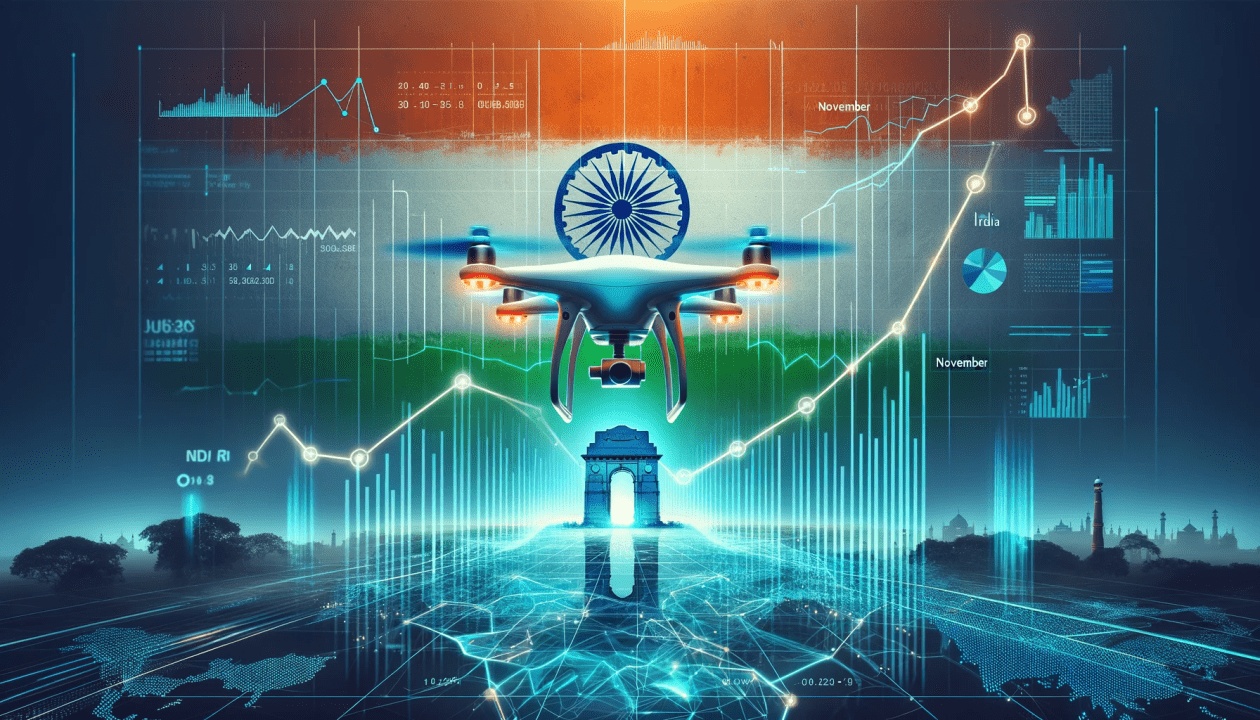
The Growing Drone Market in India: A Sky Full of Potential
The Rise of Drones in India
In recent years, India has seen a significant rise in the use of drones across various sectors. While drones initially made waves in the defense sector, their commercial applications have expanded exponentially, thanks to technological advancements and government policies that support innovation. In 2021, India’s drone market was valued at approximately USD 1.2 billion, with projections indicating this number could grow to USD 5.8 billion by 2030.
The growing demand for drones is attributed to several factors:
Affordability and Accessibility: Drones have become more affordable, and as technology improves, consumer drones are now more accessible to hobbyists and businesses alike.
Technological Advancements: Innovations in battery life, camera quality, and flight stability have made drones far more efficient and practical for everyday use.
Government Regulations: The Indian government has played an instrumental role in creating a conducive environment for drone operations. With the introduction of the Drone Rules 2021, the Indian government has simplified the process for both drone manufacturers and users, paving the way for smoother operations and more widespread adoption.
Key Sectors Benefiting from Drones in India
Agriculture:Agriculture is one of the biggest beneficiaries of drone technology in India. With India being an agrarian economy, drones are revolutionizing farming practices. Farmers are using drones for crop monitoring, pest control, and precision spraying, making it easier to manage large farms and improve yield efficiency. Drones allow for precise application of fertilizers and pesticides, which not only reduces waste but also lowers costs for farmers.
Filmmaking and Photography:In the creative industries, drones have redefined how filmmakers and photographers capture breathtaking aerial footage. From Bollywood movies to documentary productions, drones offer a unique perspective that was previously inaccessible without expensive equipment like helicopters or cranes. The rise of drone-based aerial cinematography is one of the most popular and visible applications in India, with the demand for aerial shots increasing rapidly.
Real Estate and Infrastructure:Real estate developers, architects, and construction companies are increasingly adopting drones for site surveys, aerial photography, and monitoring construction progress. Drones offer a cost-effective and efficient way to get high-quality aerial footage, helping realtors showcase properties from a new angle and provide potential buyers with a comprehensive view of developments.
Disaster Management and Surveillance:Drones have shown their potential in disaster management by assisting in search and rescue operations, surveying damage, and delivering critical supplies to areas that are hard to reach. In addition, drones are widely used in surveillance and monitoring of large crowds, offering security forces a more effective way to manage public safety during events or protests.
Logistics and Delivery:Drones are also making their mark in the logistics industry. With companies like DHL and Amazon piloting drone delivery systems across the globe, India is quickly following suit. Drone-based delivery services promise to improve last-mile delivery, reduce traffic congestion, and accelerate supply chain processes.
Defense and Security:While this is an obvious application in India, the defense sector continues to drive much of the innovation and development of drones. The Indian armed forces use drones for surveillance, reconnaissance, and border patrolling, while law enforcement agencies utilize drones to monitor urban spaces and large gatherings, providing enhanced security measures.
Challenges Facing the Drone Market in India
While the drone market in India holds immense promise, there are a few challenges that need to be addressed for its full potential to be realized.
Regulatory Hurdles:Despite the government’s efforts to create more favorable regulations, the drone industry in India still faces bureaucratic hurdles. Drone operators must adhere to strict rules regarding airspace restrictions, permission requirements, and flight limitations. These regulations can be complex for new entrants to navigate, though the recent Drone Rules 2021 have streamlined some of these processes.
Privacy and Safety Concerns:The increasing use of drones has raised concerns about privacy and data security. Drones are equipped with high-definition cameras that can capture detailed footage, leading to fears of surveillance or invasion of privacy. In response, the government has introduced measures to ensure that drones operate in a manner that protects the privacy of citizens.
Limited Infrastructure:India still lacks the comprehensive infrastructure needed to support widespread drone operations. This includes the absence of designated drone corridors, advanced air traffic management systems, and drone-friendly areas in urban settings. As drone adoption grows, there will be a need for infrastructure investments to facilitate smoother operations.
Lack of Skilled Workforce:The drone industry requires a skilled workforce capable of operating, maintaining, and troubleshooting drone technology. While there is growing demand for drone operators, there is still a shortage of certified training programs and skilled professionals. Expanding drone training initiatives will be essential to meet the rising demand for drones across industries.
The Future of the Drone Market in India
The future of drones in India looks bright, with significant growth potential. The government’s ongoing efforts to promote innovation in the drone sector, coupled with increasing awareness of their benefits, will drive the widespread adoption of drones in commercial and personal spaces.
India’s booming startup ecosystem has also played a significant role in the advancement of drone technology, with several homegrown companies developing cutting-edge drones for a variety of applications. These local startups are not only catering to the Indian market but are also gaining attention globally, positioning India as a hub for drone innovation.
As technological advancements continue and regulations evolve, we can expect drones to become more integrated into our daily lives, providing innovative solutions across sectors like logistics, healthcare, agriculture, and entertainment. The integration of artificial intelligence (AI), machine learning, and 5G technology with drones will likely propel the industry to even greater heights.
